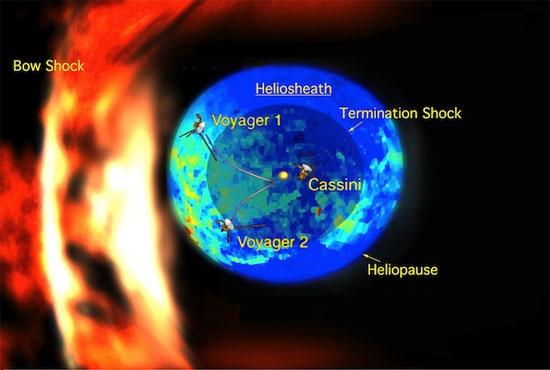Voyager crossed the solar system
NASA has just published a surprising study of the universe from data obtained by Voyager-1.
The ship is part of the Voyager project, which consists of two Voyager-1 and Voyager-2 twin probes, launched by the US Space and Aeronautics Agency (NASA) on May 9, 1977 with a mission. The first is studying nearby planets and then the outer space of the solar system.
35 years - 17 hours
This is NASA's most ambitious space program, beginning in the 1970s. Thanks to the advantage of the planet's rotation, NASA was able to use spacecraft launcher technology to support it by the gravitational field. guide. This technique allows ships to reach very high speeds without much thrust. Voyager-1 and Voyager-2 were launched using this technique.

The heliopause model of the Voyager-1 is moving inside.(Source: WIRED)
In addition to research purposes, these two ships also carry the hope of humanity to seek life outside the solar system. Voyager brought gold-plated discs to record the sounds and images of life on Earth to introduce extraterrestrial civilization if Voyager really fell into their hands.
To operate, Voyager is equipped with 16 hydrazine propulsion engines, balance systems and many scientific measuring tools. Both have an atomic power supply unit, equipped with 24 plutonium spheres, enough to power the operating vessel by 2025. Radio signaling systems are designed to be able to transmit signals at about how to get out of the solar system.
Interesting surprises
As of June 29, Voyager-1 traveled a huge distance of 24.67 AU (about 18 billion km). This distance equals 120 times the distance from the earth to the sun. This made Voyager-1 the most distant man-made object ever, surpassing its brother, the Voyager-2, now traveling 15 billion km.
Initially, scientists assumed that at this distance, Voyager-1 would enter the edge of the solar system, where the influence of the sun would begin to diminish but the data of Voyager-1 showed. The effect of this fringe is much more complex, even against all previous predictions.
There the sun continually creates 'solar winds' and plasma rays gathered by energy particles. These "winds" blow on the surface of the sun at supersonic speeds and radiate around, forming a gravitational field called solar 'magnetic field'. This force field constitutes a ' heliosphere ' bubble , the area where the force of the solar field is still outstanding. Outside the solar system, there is a specific gravitational field, a region that possesses a 'flow' of different energy particles, created by the massive explosions of other stars.
When Voyager-1 started entering the edge of the heliosphere bubble in 2003, the influence of the sun became weaker. But strangely, the data obtained by Voyager-1 shows that the 'flow' from cosmic rays is stable in one direction, not as expected. There was not even a change of magnetic field. This discovery opens up a new hypothesis, which is the existence of a buffer zone between the outer space of the sun and the outer universe, which is named the heliopause . This buffer zone acts as a border area, not necessarily inside the solar system, but not exactly outside the outer space.
This is a discovery that confuses scientists. Voyager-1's journey continues and doesn't know what will happen .
Mysterious heliopause buffer
The existence of the heliopause buffer zone is not entirely part of any computational model of scientists and it is unknown when Voyager-1 will go beyond this buffer.'It can happen at any time. We don't have a model that is accurate to predict that, ' said Ed Stone, a physicist at Voyager. This discovery will force space scientists to return to the research desk because it seems like the imagination is much more imaginative than us.
- Voyager 2 leaves the Solar System, enters the interstellar realm
- People are about to leave the Solar System
- Voyager 1 was out of the solar system
- The American spacecraft exits the solar system
- Voyager 1 overview
- NASA Voyager 1 spacecraft comes to the edge of the solar system
- Voyager's controversy
- The American airship is about to fly out of the solar system
- Voyager 1 is about to
- Voyager 1 touch lane
- Voyager 2 Explorer: Discovery of the Curved Solar System
- Voyager 2 overview
 Van Allen's belt and evidence that the Apollo 11 mission to the Moon was myth
Van Allen's belt and evidence that the Apollo 11 mission to the Moon was myth The levels of civilization in the universe (Kardashev scale)
The levels of civilization in the universe (Kardashev scale) Today Mars, the sun and the Earth are aligned
Today Mars, the sun and the Earth are aligned The Amazon owner announced a secret plan to build a space base for thousands of people
The Amazon owner announced a secret plan to build a space base for thousands of people